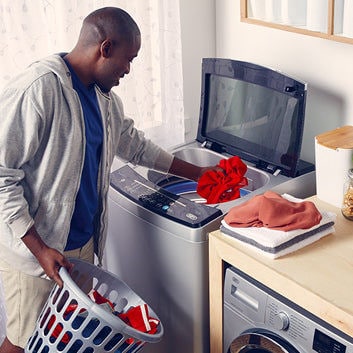There are many domestic appliances consumers can learn to live without, but when it comes to washing machines, even one day without is one too many.
But the big question is which washing machine front loader or top loader? Here’s a breakdown of the two.
Top loader washing machine
These washing machines use a centre agitator and paddles to move clothes through the water from top to bottom, loosening dirt. There is a control system and mechanical system. The control system has the load size selector, temperature selector, timer and lock. The mechanical system has a motor, clutch, transmission, wash tubs, water valve, agitator, pumps, suspension system and belt or motor coupling.
Pros of a top loader washing machine
These washing machines remain a popular choice with consumers the world over for a number of reasons:
●Cycle times: The top loader has a much faster cycle time than front loaders, which means that vast quantities of laundry can be done in significantly less time. Typically, top loaders have a run cycle of about 15 to 30 minutes faster than traditional front loaders, which can take up to an hour.
●Capacity: The top loader has a larger capacity than similarly sized front loaders, in both the domestic and commercial models.
●Ergonomics: The simple fact that laundry is loaded at the top of the machine, rather than the user having to bend to insert laundry, makes top loaders beneficial. This is particularly helpful for the elderly community or those suffering from back problems.
●Additional laundry: If you’ve forgotten to throw in certain items of clothing, you can add them too during the wash cycle, whereas front loaders lock during a cycle.
●Fabric softeners: Top loaders are known to respond better to fabric softeners than front loader washing machines.
●Cost: Top loaders are considerably lower in price than their front loader counterparts. This makes them a popular choice for laundromats as well as apartment blocks and university accommodation with community laundry rooms.
Cons of a top load washers
For the savings in costs, consumers will have to consider the downsides to the top loader washing machine.
●Efficiency: Top loaders are less efficient than front loaders, using much more water and energy. This makes them costlier in the long run.
●Noise: Top loaders are often a lot noisier because of the friction created between clothes when twisting in the wash.
●Layout: Many modern kitchens and laundries are designed for a washing machine to be fitted under a counter or cabinet for a slick finish.
Front load washing machines
Like the top loader washing machine, the front loader has a stainless steel inner drum, an outer washtub, motor, control system, drain pump and rotational spinning. However, a front loader fills the bottom of the inner tub with some water and uses rotation and gravity to move clothes through water.
The side paddles lift the clothes and move them in and out of the water to remove dirt.
Pros of a front loader washing machine
Here’s a look at why front loader washing machines are starting to overtake the traditional top loaders in popularity.
●Energy efficiency: Front loaders use less water and energy because the fit of the drum relies more on gravity. This means the clothes don’t need to be saturated with water the entire time, using up to 50% less water.
●Detergent efficiency: Front loaders use less detergent, further saving on costs.
●Features: Front loaders have more cycle options and modern features. Defy’s range of washing machines are a good example, offering consumers auto programming and innovative SteamCure technology for a better clean using less energy. Using steam, the system minimises water consumption, using less energy for a quicker cycle.
●Better for laundry: Front loaders are a lot gentler on the clothes, meaning less wear and tear,
●and they also don’t deposit lint during a wash cycle.
● Reliability: Because they use gravity to turn the clothing, they require fewer repairs on major parts, making them the more reliable option.
● Quieter: They create a lot less noise than a top loader washing machine, particularly during a spin cycle. Many front loaders have a vibration control feature to stabilise the internal drum.
● Versatile locations: Front loaders can be placed in a closet, or elevated on counter out of the way. Some washing machines come with additional features such as a steam setting, a self cleaning cycle, or reversible washer doors.
Cons of a front load washer
Despite being the preferred washing machine appliance, front loaders have a few drawbacks, including:
● Time consuming: These washing machines take quite a bit longer to clean clothes than a top loader.
● Capacity: Front loaders are designed for domestic use as they have a much lower capacity than top loaders.
● Sensitivity: If you overload a front loader, you are likely to wear out the drum bearings. While this might be risky for top loaders, it’s a lot more harmful for front loaders.
● Mould: The rubber seal means that any incorrect detergent could lead to mould and mildew which is problematic for laundry.
● Ergonomic issues: Unless a washing machine is elevated, it can cause ergonomic issues for users having to bend down to use them. For domestic use, the front loader washing machine is comparably the better choice for the majority of consumers, however, this obviously depends on independent elements such as space configurations, load capacity and energy consumption. To find out how energy efficient a particular washing machine is, the Department of Energy has outlined the Minimum Energy Performance Standards (MEPS) and, currently, washing machines with an energy efficiency rating of Class A can be sold.



